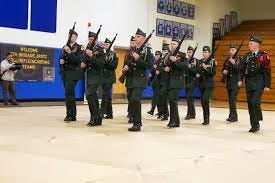The JROTC program puts guns in students hands along with a healthy does of racial bias

Article first appeared in alternet.org:
It should be no secret that the United States has the biggest, most efficiently organized, most effective system for recruiting child soldiers in the world. With uncharacteristic modesty, however, the Pentagon doesn’t call it that. Its term is “youth development program.”
The U.S. Army Junior Reserve Officers’ Training Corps was conceived as part of the National Defense Act of 1916 in the midst of World War I. In the aftermath of that war, however, only six high schools took up the military's offer of equipment and instructors. A senior version of ROTC, was made compulsory on many state college and university campuses, despite the then-controversial question of whether the government could compel students to take military training.
By 1961, ROTC had become an optional program, popular at some schools, but unwelcome on others. It soon disappeared altogether from the campuses of many elite colleges and progressive state universities, pushed out by protest against the war in Vietnam and pulled out by the Pentagon, which insisted on maintaining discriminatory policies (especially regarding sexual preference and gender) outlawed in university codes of conduct. When it gave up “ Don’t Ask, Don’t Tell” in 2011 and offered a menu of substantial research grants for such institutions, elite universities like Harvard and Yale welcomed the military back with unbecoming deference.
Almost half a century after Army JROTC was established, the Reserve Officers Training Corps Vitalization Act of 1964 opened such junior training to all branches of the military. What’s more, the number of JROTC units nationwide, previously capped at 1,200, climbed rapidly until 2001, when the very idea of imposing limits on the program disappeared.
The Pentagon claims that JROTC is not a recruiting program. Privately, it never considered it to be anything else. Army JROTC now describes itself as having “evolved from a source of enlisted recruits and officer candidates to a citizenship program devoted to the moral, physical, and educational uplift of American youth.” Yet former Defense Secretary William Cohen, testifying before the House Armed Services Committee in 2000, named JROTC “one of the best recruiting devices that we could have.”
What makes this child-soldier recruiting program so striking is that the Pentagon carries it out in plain sight in hundreds and hundreds of private, military, and public high schools across the U.S.
The JROTC program, still spreading in high schools across the country, costs U.S. taxpayers hundreds of millions of dollars annually. It has cost some unknown number of taxpayers their children.
In Boston, I asked a 14-year-old boy why he had joined JROTC. He wore a junior Army uniform and toted a rifle nearly as big as himself. He said, “My dad, he left us, and my mom, she works two jobs, and when she gets home, well, she’s not big on structure. But they told us at school you gotta have a lot of structure if you want to get somewhere. So I guess you could say I joined up for that.”
A group of girls, all Army JROTC members, told me they took classes with the boys but had their own all-girl (all-black) drill team that competed against others as far away as New Jersey. They showed me their medals and invited me to their high school to see their trophies. They, too, were 14 or 15. They jumped up and down like the enthusiastic young teens they were as we talked. One said, “I never got no prizes before.”
I sat in on JROTC classes where kids watched endless films of soldiers on parade, then had a go at it themselves in the school gym, rifles in hand. (I have to admit that they could march far better than squads of the Afghan National Army, which I’ve also observed, but is that something to be proud of?) Since those classes often seemed to consist of hanging out, students had lots of time to chat with the Army recruiter whose desk was conveniently located in the JROTC classroom.
A 16-year-old African American girl, who was first in her class and had already signed up for the Army, told me she would make the military her career. Her instructor -- a white colonel she regarded as the father she never had at home -- had led the class to believe that “our war” would go on for a very long time, or as he put it, “until we’ve killed every last Muslim on Earth.” She wanted to help save America by devoting her life to that “big job ahead.”
Stunned, I blurted out, “But what about Malcolm X?” He grew up in Boston and a boulevard not far from the school was named in his honor. “Wasn’t he a Muslim?” I asked.
Civic groups have raised a number of other objections to JROTC, ranging from discriminatory practices -- against gays, immigrants, and Muslims, for example -- to dangerous ones, such as bringing guns into schools (of all places). Some units even set up shooting ranges where automatic rifles and live ammunition are used. JROTC embellishes the dangerous mystique of such weapons, making them objects to covet, embrace, and jump at the chance to use.
http://www.alternet.org/media/americas-child-soldiers-jrotc-and-militarizing-america?page=0%2C3


